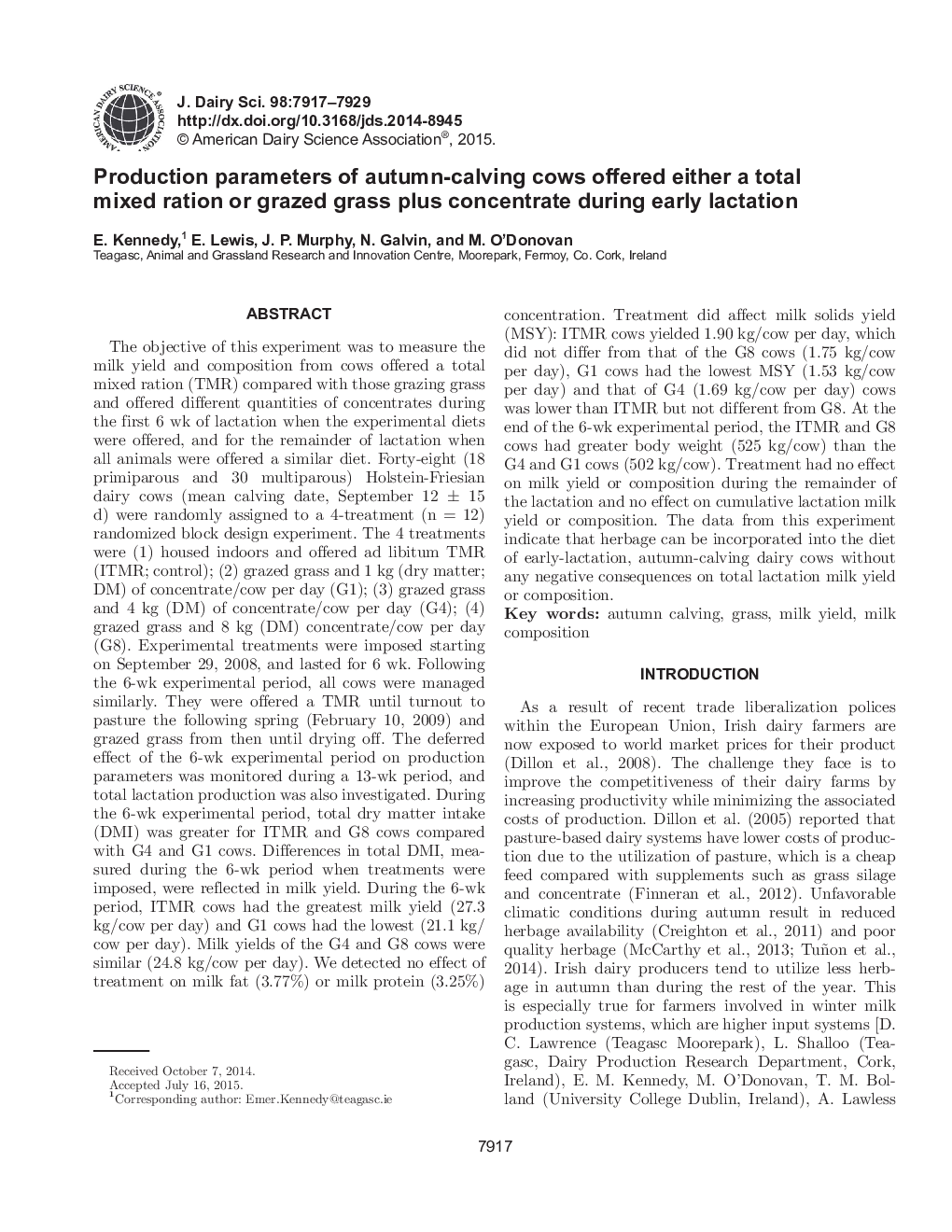| کد مقاله | کد نشریه | سال انتشار | مقاله انگلیسی | نسخه تمام متن |
|---|---|---|---|---|
| 10974558 | 1108026 | 2015 | 13 صفحه PDF | دانلود رایگان |
عنوان انگلیسی مقاله ISI
Production parameters of autumn-calving cows offered either a total mixed ration or grazed grass plus concentrate during early lactation
ترجمه فارسی عنوان
پارامترهای تولید گاوهای پاییزه گاو یا کل گاو مخلوط شده یا چمن گاو به همراه کنسانتره در اوایل شیردهی
دانلود مقاله + سفارش ترجمه
دانلود مقاله ISI انگلیسی
رایگان برای ایرانیان
کلمات کلیدی
گوزن پاییز، چمن، عملکرد شیر، ترکیب شیر،
موضوعات مرتبط
علوم زیستی و بیوفناوری
علوم کشاورزی و بیولوژیک
علوم دامی و جانورشناسی
چکیده انگلیسی
The objective of this experiment was to measure the milk yield and composition from cows offered a total mixed ration (TMR) compared with those grazing grass and offered different quantities of concentrates during the first 6 wk of lactation when the experimental diets were offered, and for the remainder of lactation when all animals were offered a similar diet. Forty-eight (18 primiparous and 30 multiparous) Holstein-Friesian dairy cows (mean calving date, September 12 ± 15 d) were randomly assigned to a 4-treatment (n = 12) randomized block design experiment. The 4 treatments were (1) housed indoors and offered ad libitum TMR (ITMR; control); (2) grazed grass and 1 kg (dry matter; DM) of concentrate/cow per day (G1); (3) grazed grass and 4 kg (DM) of concentrate/cow per day (G4); (4) grazed grass and 8 kg (DM) concentrate/cow per day (G8). Experimental treatments were imposed starting on September 29, 2008, and lasted for 6 wk. Following the 6-wk experimental period, all cows were managed similarly. They were offered a TMR until turnout to pasture the following spring (February 10, 2009) and grazed grass from then until drying off. The deferred effect of the 6-wk experimental period on production parameters was monitored during a 13-wk period, and total lactation production was also investigated. During the 6-wk experimental period, total dry matter intake (DMI) was greater for ITMR and G8 cows compared with G4 and G1 cows. Differences in total DMI, measured during the 6-wk period when treatments were imposed, were reflected in milk yield. During the 6-wk period, ITMR cows had the greatest milk yield (27.3 kg/cow per day) and G1 cows had the lowest (21.1 kg/cow per day). Milk yields of the G4 and G8 cows were similar (24.8 kg/cow per day). We detected no effect of treatment on milk fat (3.77%) or milk protein (3.25%) concentration. Treatment did affect milk solids yield (MSY): ITMR cows yielded 1.90 kg/cow per day, which did not differ from that of the G8 cows (1.75 kg/cow per day), G1 cows had the lowest MSY (1.53 kg/cow per day) and that of G4 (1.69 kg/cow per day) cows was lower than ITMR but not different from G8. At the end of the 6-wk experimental period, the ITMR and G8 cows had greater body weight (525 kg/cow) than the G4 and G1 cows (502 kg/cow). Treatment had no effect on milk yield or composition during the remainder of the lactation and no effect on cumulative lactation milk yield or composition. The data from this experiment indicate that herbage can be incorporated into the diet of early-lactation, autumn-calving dairy cows without any negative consequences on total lactation milk yield or composition.
ناشر
Database: Elsevier - ScienceDirect (ساینس دایرکت)
Journal: Journal of Dairy Science - Volume 98, Issue 11, November 2015, Pages 7917-7929
Journal: Journal of Dairy Science - Volume 98, Issue 11, November 2015, Pages 7917-7929
نویسندگان
E. Kennedy, E. Lewis, J.P. Murphy, N. Galvin, M. O'Donovan,
